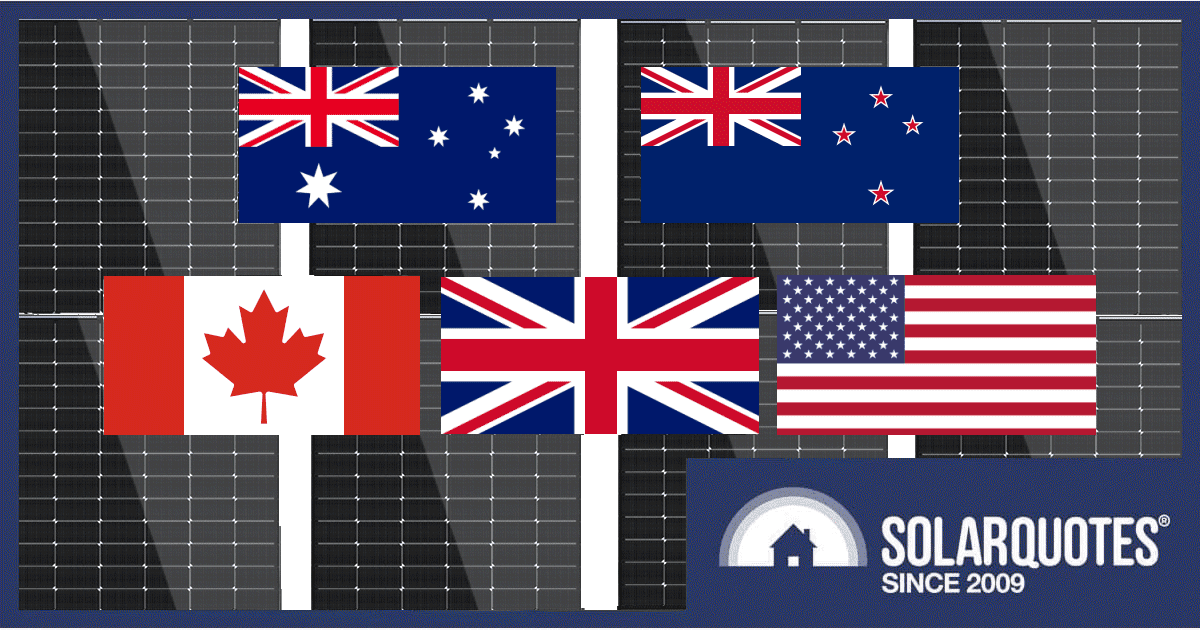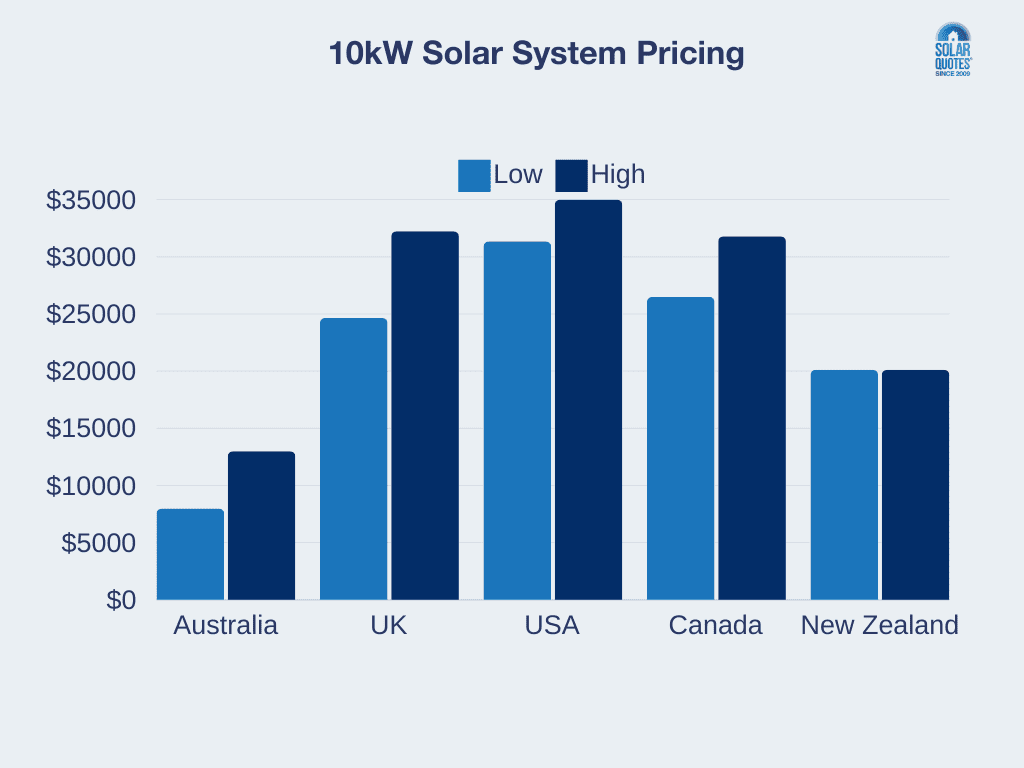
Home solar power system prices remain far cheaper in Australia than in the USA, UK, Canada and New Zealand. Here’s how they compare.
The USA achieved a significant milestone very recently – more than five million solar installations. The Solar Energy Industries Association (SEIA) forecasts the number will double to 10 million by 2030 and triple to 15 million by 2034. The residential sector accounts for 97% of all solar installations, and SEIA estimates around 7% of all homes have panels. By 2030, this will grow to more than 15% of U.S. homes.
5 million systems is impressive, but we’ve still got them beat on several metrics. Home solar uptake in Australia has been phenomenal, with 3,800,149 small scale (<100kW) installations as at the end of April this year. And we’ve achieved that with a population of just 26.67 million compared to the USA’s 341.6 million.
So, why has Australia done so well? A lot of it is down to cost, which is much lower here. This is thanks in part to the “solar rebate”, which is still available today, and other favourable policies.
Rebates Kick Off Australia’s Home Solar Revolution
It may come as a surprise to some, but it was Liberal PM John Howard who introduced Australia’s Renewable Energy Target way back in 2001. Then in May 2007, Mr. Howard introduced an $8,000 rebate for solar systems. At the time, a piddly 1kW system cost around $12,000 before the rebate.
The impact of that initial rebate (the nature of the incentive has changed since), other policy settings and reduction in component costs had a big impact, very quickly. 1,115 systems were installed in 2006, 3,480 in 2007 and 14,064 in 2008. Fast forward to last year and approximately 328,243 were installed (Source: Clean Energy Regulator). But 2023 wasn’t the best year so far. That occurred in 2021 with 377,458 installations.
AU Prices Vs. UK, USA, Canada And NZ
Nearly 2 years ago, I compared prices of 6.6kW systems in Australia with the UK and USA, which was the most common capacity being purchased here at the time. I thought I’d poke around again, but comparing larger 10kW solar systems – as that’s generally what the cool kids here are getting if they have the roof space (some even more). This time around, I’ll also throw in figures from Canada and our cousins across the ditch.
- 10kW – Australia: $8,000 – $13,000
- 10kW – UK: £13,000 – £17,000 (AUD ~ $24,650 – $32,240)
- 10kW – USA: USD $21,000 – $35,0001 (AUD ~ $31,350 – $52,254)
- 10kW – Canada: CAD ~$24,200 – $29,000 (AUD ~ $26,500 – $31,800)
- 10kW – New Zealand: around NZD $22,000 (AUD ~ $20,120)
Australian prices for a 10kW system are based on a good quality system, competently installed and after the rebate.
Australians are privileged to live in the best country in the world2 in a number of aspects – and affordable good quality solar is among them.
Footnotes
- This cost is reduced by the Investment Tax Credit (ITC); a 30 percent tax credit for individuals installing solar systems on residential property. If I’m understanding correctly how it works, and based on the 31k price, it could knock off around 10k in a round-about sort of way – unless you don’t have the tax liability to benefit from it. ↩
- OK, some possible bias here. ↩


 RSS - Posts
RSS - Posts



The real question is why? The incentives are not even close to explaining the difference.
Good question Alex. It’s hardly about “Economies of scale” or the relative wages of Electicians/Installers, so it must come down to that ever-reliable capitalist determinant, Supply vs Demand – maybe just not enough competition on the Supply side. Then again, I can understand the higher prices in the UK given all those steep, slate-tiled roofs – reckon they’d require a bit of pre-planning to install panels on.
Hi Peter,
I’ve been to Scotland and seen the slate roofs and cast iron gutters, you couldn’t pay me enough to do that work.
Though some of them look slick when they flash around the array and end up with the glass flush with the cladding.
I live in the U.S., in Maine. When I first saw Australian solar prices I thought it must be a misprint; the bare components cost me more than what you pay for an installed system.
U.S. prices vary widely, but prices in Maine are higher than the range you quoted. In February my neighbor was quoted $40,396 USD ($60,700 AUD) for a 9.7 KW grid-tie solar system by an installer generally considered one of the least expensive. That’s about $4.16 USD or $6.25 AUD per watt. Another neighbor paid similar prices to a different installer.
Maine has no State incentives for solar, and no state income tax credits for solar. There is a 30% federal ITC which you can use to reduce your federal income taxes. But many people don’t have enough income to take advantage of it.
In 2019 I was quoted $21,303 USD for a 7.68 KW system, or about $26,200 USD ($39,400 AUD) in today’s dollars, or $3.41 USD ($5.13 AUD) per watt. Even under the best assumptions the payback was over 15 years. What made Maine so difficult for solar was that you had to sell ALL the power your solar system produced, including power your house consumed immediately, to the local utility for half price, then buy your own power back at the full retail price to use in your home. That’s like a law that says if you grow tomatoes, you have to sell ALL of them to the local supermarket, then if you want to eat your own tomatoes, you buy them back at twice the price.
Maine’s new Governor has changed the law to net metering. We no longer have to pay the utility for the solar power we generate and consume internally, and we get KWh credits for any excess we send to the grid. We have 12 months to use those KWh credits we have ‘banked’. That makes solar feasible in Maine, but still much more expensive than in Australia. And in addition, I live further from the equator than Tasmania. I sure wish we had your prices – and your sun!
P.S. The USA High price bar on your bar graph should be $52,234 not $35,000.
Thank you Gary,
For your detailed comment and realising that Australia is in fact a real place, we’re not all actors 😉
The good people operating in the solar industry here often lament that the sportzball stars selling crap on TV are winning the race to the bottom on price, and of course quality.
We generally find a good operator will offer solar systems at around $1000/kW installed, (including STC incentives) while batteries are serendipitously $1000/kWh
Sounds like your previous electricity metering was insane, are the utilites publicly owned? I’m glad that’s been cleared up anyway.
The previous governor hated solar and did everything he could to kill it. His ‘Gross Metering’ policy was very effective at that.
It’s very interesting you should ask that question. Two utilities serve 90% of the state and both are private companies. There has been a movement in Maine to take them over and make them public utilities. The bills always failed in the legislature, but when electricity prices doubled in 2022, they got a referendum on the ballot. It was the first time an entire state had voted to take a utility by eminent domain, and it was national news.
The proposal made no sense to me. Distribution is roughly 6 cents, transmission 3 cents, and generation 19 cents per KWh. By law the utilities can’t own generation, and transmission is regulated federally. Taking over the utilities could only save a portion of the 6 cent charge, but the interest on the $10 billion bond to buy out the utilities was estimated to be 3 to 5 cents per KWh. There was no way they could continue to operate on 1 to 3 cents per KWh, let alone reduce those prices. The referendum failed, but they are already trying again. In my opinion they should be trying to reduce the cost of generation, not distribution. But since the generation charge is included on the consolidated utility bill, people blame the company whose name is on the bill for the high prices.
U.S. voters make poor energy choices. Massachusetts offered to pay the entire cost to bring hydro power from Canada to the New England grid, but the lines had to go through Maine. Maine voters balked at cutting a 53 mile corridor through the woods and voted to stop the half-completed line. Literally 2 weeks later electricity doubled in price due to natural gas prices. Generation by gas is 4 times the cost of hydro. Now the line is being built, but the work stoppage increased the cost from $900 million to $1.5 billion USD. We keep shooting ourselves in the foot.
Hi Gary,
Thanks for the update. It’s interesting to see that we’re not the only ones who are having trouble with managing energy and the transition to renewables. The “climate wars” waged by the regressives here have done immense damage to climate and economy in the name of political point scoring. We had a carbon tax but that’s now so politically toxic it’ll be a generation before anyone even thinks about revisiting it.